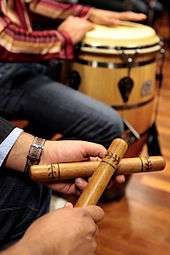Idiophone

.jpg)

An idiophone is any musical instrument that creates sound primarily by the instrument as a whole vibrating—without the use of strings or membranes. It is the first of the four main divisions in the original Hornbostel–Sachs scheme of musical instrument classification (see List of idiophones by Hornbostel–Sachs number). The early classification of Victor-Charles Mahillon called this group of instruments autophones.
Most percussion instruments that are not drums are idiophones. Hornbostel–Sachs divides idiophones into four main sub-categories. The first division is the struck idiophones (sometimes called concussion idiophones). This includes most of the non-drum percussion instruments familiar in the West. They include all idiophones made to vibrate by being struck, either directly with a stick or hand (like the wood block, singing bowl, steel tongue drum, triangle or marimba) or indirectly, by way of a scraping or shaking motion (like maracas or flexatone). Various types of bells fall into both categories.
The other three subdivisions are rarer. They are plucked idiophones, such as the Jew's harp, amplified cactus, mazanki, kouxian, dan moi, music box and mbira (lamellophone or thumb piano); blown idiophones, of which there are a very small number of examples, the Aeolsklavier being one; and friction idiophones, such as the singing bowl, glass harmonica, glass harp, turntable, verrophone, daxophone, styrophone, musical saw, and nail violin (a number of pieces of metal or wood rubbed with a bow).[1]
Other classifications use six main sub-categories: Concussion idiophones are instruments that produce sound by being struck against one another. Percussion idiophones produce sound by being struck with a non-vibrating foreign object. Examples of non-vibrating objects are mallets, hammers, and sticks. Rattle idiophones are shaken. Scraper idiophones are instruments that are scraped with a stick or other foreign objects to give off a sound. Plucked idiophones produce sound by plucking a flexible tongue from within the instrument itself. Lastly, friction idiophones are rubbed to increase vibration and sound intensity.[2]
Idiophones are made of materials that give off unique sounds. The majority of idiophones are made out of glass, metal, ceramics, and wood. Idiophones are considered part of the percussion section in an orchestra.
A number of idiophones that are normally struck, such as vibraphone bars and cymbals, can also be bowed.
See also
References
- ↑ Don Michael Rendel, ed., The New Harvard Dictionary of Music, 1986.
- ↑ "Idiophones", The Most Comprehensive Music Technology Glossary.
External links
| Wikimedia Commons has media related to Idiophones. |
Hornbostel–Sachs system | |||||||||||||||
|---|---|---|---|---|---|---|---|---|---|---|---|---|---|---|---|
| |||||||||||||||
| |||||||||||||||
| |||||||||||||||
| |||||||||||||||
| |||||||||||||||